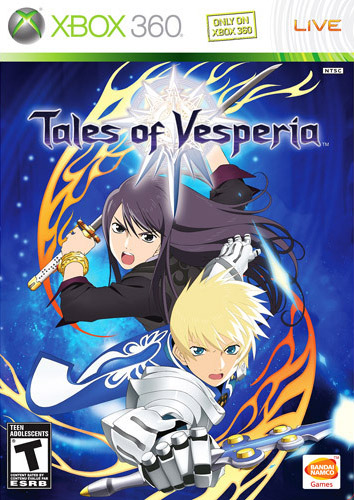In my mind, the best kind of RPG is a well-plotted fantasy novel. I want fun characters and a clever, fully-developed world with large-scale problems. I don’t mind the cliches as long as there’s a solid story, and I don’t even mind predictability as long as something surprises me along the way. I know there are people out there who live for the combat in RPGs, even on trash. I’m not one of them. I like story and I like boss fights and I slough through the trash in between because I want to know what happens. I have no patience for repetitive grinding but exceptional patience for cut scenes, animations, and character development.
Now that you know that, I can tell you that Tales of Vesperia is easily the best next-gen RPG I’ve ever played, and quite possibly the best RPG I’ve played on any platform. It debuted last year on the Xbox 360 (and I believe you can download a free demo through Xbox Live, though don’t quote me on that).
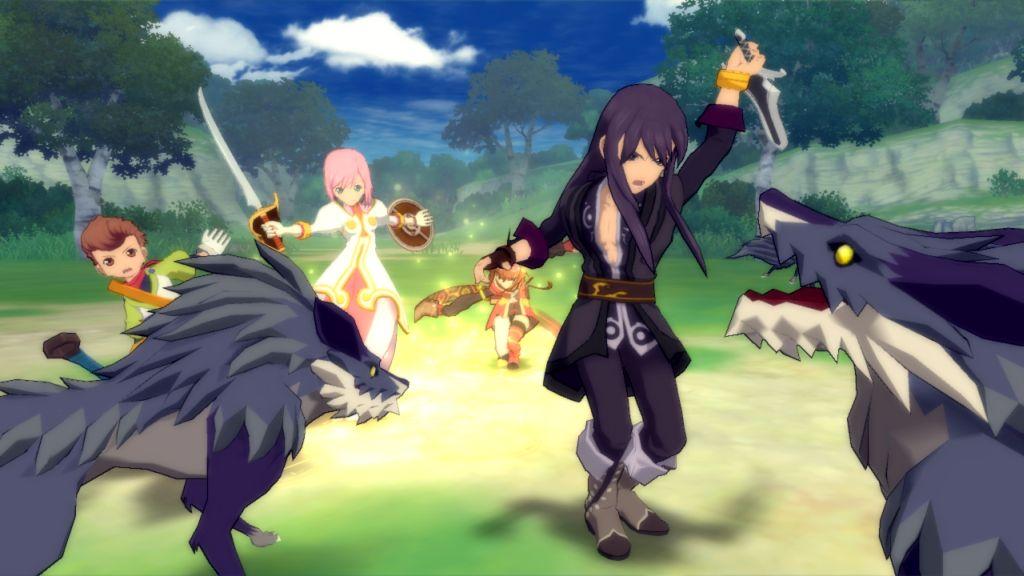 Tales of Vesperia takes place on Terca Lumereis, a world in which humans are pretty small on the grand scale, struggling to survive in a very harsh world. Humans live in sheltered cities that are protected by blastia, an ancient technology that no one quite fully understands. Blastia do everything from fuel fountains (“aque blastia”) to enhance combat abilities (“bodhi blastia”), and protect cities from the dangerous monsters outside (“barrier blastia”). Blastia are fueled by a substance called “aer” that exists throughout the world. It is essential in small qualities and devastatingly dangerous in large quantities.
Tales of Vesperia takes place on Terca Lumereis, a world in which humans are pretty small on the grand scale, struggling to survive in a very harsh world. Humans live in sheltered cities that are protected by blastia, an ancient technology that no one quite fully understands. Blastia do everything from fuel fountains (“aque blastia”) to enhance combat abilities (“bodhi blastia”), and protect cities from the dangerous monsters outside (“barrier blastia”). Blastia are fueled by a substance called “aer” that exists throughout the world. It is essential in small qualities and devastatingly dangerous in large quantities.
The protagonist (I hesitate to call him “hero”), Yuri, is from the Lower Quarter of the capital city. He once joined the Imperial Knights, the men and women who protect the capital and defend the Empire, but quit when he felt the Empire wasn’t really doing more to protect its own interests than to protect its citizens. His childhood best friend, Flynn, remained in the Knights and tries to work for justice within the system. After the aque blastia in the Lower Quarter is stolen, Yuri is determined to find out who is responsible and restore the blastia to his home.
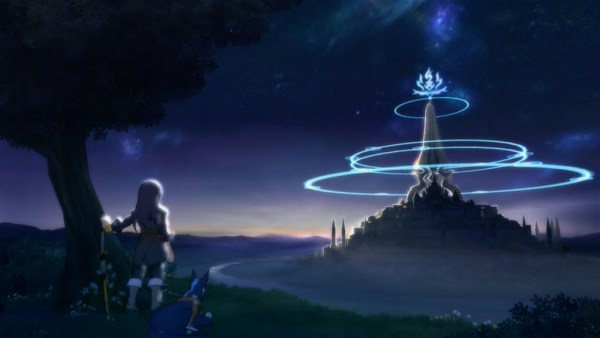 His quest for the blastia turns into an journey on a scale far beyond what he had imagined. Enter political intrigue, warring factions, duplicity, ancient races, spirits, monsters, and a conspiracy (whose details are obscured by corruption). Yuri joins up with an assortment of characters along the way, and I won’t bore you with the details (or spoil the surprises) but suffice it to say that each and every person he meets up with is wonderful and charming and just the sort of person you’d want to hang out with for 60-70 hours of playing time. The main character is dark and brooding but funny and only seems to angst self-effacingly. The pink princess is naïve, but she’s not stupid—she’s just lacking in experience, and she gets that during the course of the story and really grows into herself. Each character has his or her own motives, and his or her own goals. They are brought together by convenience but stay together out of loyalty and mutual respect. No one feels tacked on, and their relationships to each other feel real because you watch them form before you.
His quest for the blastia turns into an journey on a scale far beyond what he had imagined. Enter political intrigue, warring factions, duplicity, ancient races, spirits, monsters, and a conspiracy (whose details are obscured by corruption). Yuri joins up with an assortment of characters along the way, and I won’t bore you with the details (or spoil the surprises) but suffice it to say that each and every person he meets up with is wonderful and charming and just the sort of person you’d want to hang out with for 60-70 hours of playing time. The main character is dark and brooding but funny and only seems to angst self-effacingly. The pink princess is naïve, but she’s not stupid—she’s just lacking in experience, and she gets that during the course of the story and really grows into herself. Each character has his or her own motives, and his or her own goals. They are brought together by convenience but stay together out of loyalty and mutual respect. No one feels tacked on, and their relationships to each other feel real because you watch them form before you.
That said, it’s a video game and not an anime, so let’s talk about the combat system. It’s technically called the “Evolved Flex-Range Linear Motion Battle System” (EFR-LMBS) but that’s not very helpful, is it? Combat is real time, not turn-based. There’s no gauge, no stopping to queue actions, and no tedious ten minute fights. Encounters work more like a fighter game—you map special abilities, called “artes,” to your controller, and combine those with regular attacks to execute combos and unlock more powerful attacks. Fights are more like skirmishes this way—short, exciting, real-time. This system has utterly spoiled me to the point that I am having a really hard time returning to turn-based combat. You choose four people for your party, and more than one can heal. Nuts, right? The AI is better than pretty much any game I’ve played, though it’s not perfect. It helps to take a heavier guiding hand, but the good news is that when issuing orders to other party members the fight pauses.
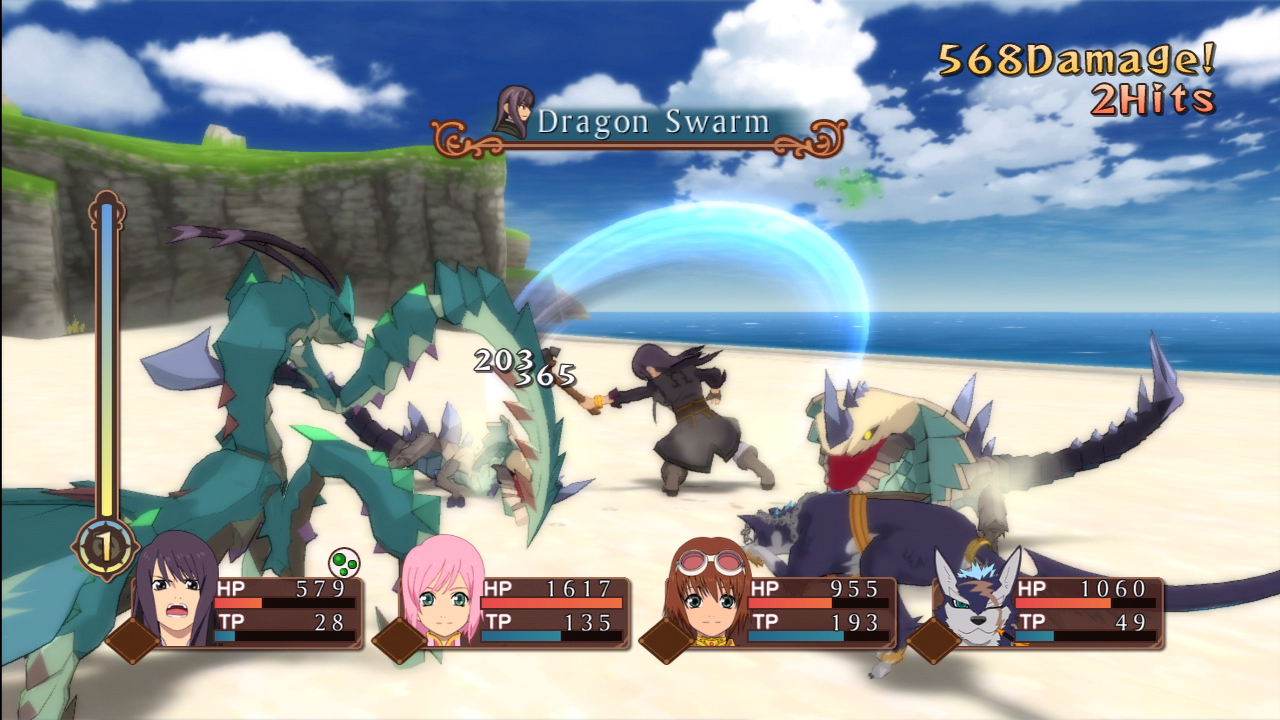
The weapons that you find along the way often have “Skills” attached to them, and once you’ve used that weapon enough you permanently keep the skill and its associated bonuses. It’s what the Final Fantasy XII system should’ve been: simple and powerful. The flavor text on some of these items is also not to be missed.
Finally, this is a multiplayer RPG. The actual story is one player, but in any of the fights you can have up to three other friends join you and control the other characters for combat. I can’t tell you what a great feature this is, and it seems to be exclusive to the Tales series.
Tales of Vesperia is in many ways a Thomas Morian debate about justice. If you see injustice in the world and the system in place does not right the wrong that you see, do you work from within the system, or do you work outside the system? If a good person does a terrible thing for a good reason, is he right? If a bad person does a good thing for a terrible reason, is he wrong? It’s a story about difficult moral choices, but it’s not a morality tale—there is no right or wrong answer, and the characters themselves struggle with the questions. According to Wikipedia this is a specific subgenre of the Japanese RPG known as the “To Enforce One’s Justice RPG” (?????????RPG , “Seigi” o tsuranukit?su RPG) . Makes me wonder what other games fit the bill and what answers they came up with.
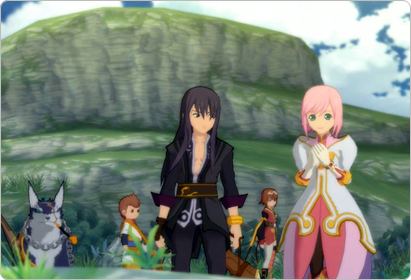 The character design is good, the voice acting is spectacular, and the game is sprinkled with non-essential but fun “skits” that you can watch—optional cut-scenes, basically, in which the characters bicker and banter. The designers created a beautiful, believable world. The art is absolutely stunning. To walk through a palace and see the chandeliers reflected in the marble floors is to appreciate the art of cell-shading. (You CGI folks who whine about lack of 360 cameras don’t know what you’re missing!) I played this on an HDTV and I can’t even convey how knock-out the graphics are compared to these pithy stills. Once you’ve finished the game, you re-play it with bonuses, too.
The character design is good, the voice acting is spectacular, and the game is sprinkled with non-essential but fun “skits” that you can watch—optional cut-scenes, basically, in which the characters bicker and banter. The designers created a beautiful, believable world. The art is absolutely stunning. To walk through a palace and see the chandeliers reflected in the marble floors is to appreciate the art of cell-shading. (You CGI folks who whine about lack of 360 cameras don’t know what you’re missing!) I played this on an HDTV and I can’t even convey how knock-out the graphics are compared to these pithy stills. Once you’ve finished the game, you re-play it with bonuses, too.
I truly cannot recommend the game enough. I am at the final dungeon and never once had to grind, despite skipping numerous encounters. I have some nits to pick plot-wise, but there’s really nothing bad that I can say about it. My only wish was that Americans liked JRPGs better, so that we’d have a better chance of seeing more games like this. But alas, it’s the action RPGs that rule here, so enjoy this one while you still can—the previous Tales installment, Tales of Symphonia, is already difficult to find.










